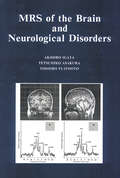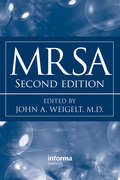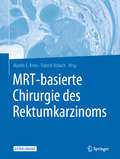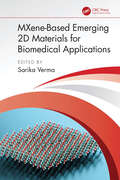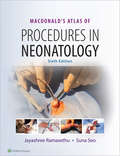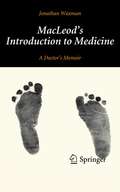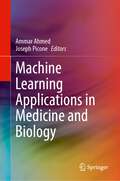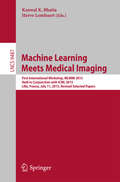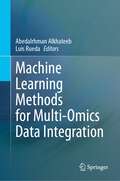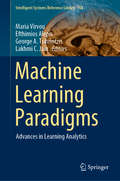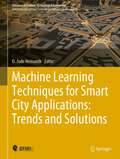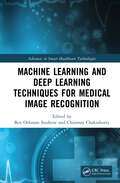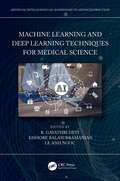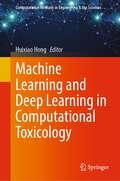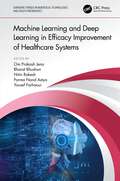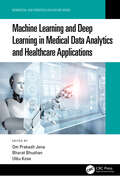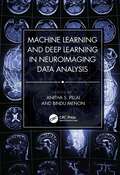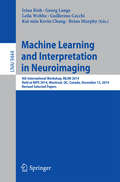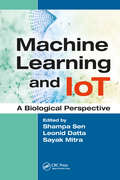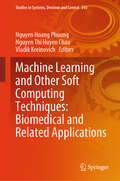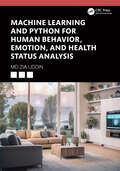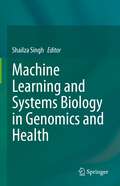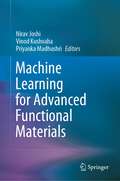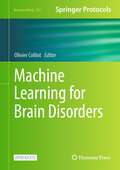- Table View
- List View
MRS of the Brain and Neurological Disorders
by Akihiro Igata Tetsuhiko Asakura Toshiro FujimotoMRS of the Brain and Neurological Disorders illustrates and demonstrates the usefulness of magnetic resonance spectroscopy for the diagnosis of brain and neurological disorders, including epilepsy, nervous disorders, psychiatric disorders, and brain tumors.The book is unique in that it contains 87 case studies of neurologic and psychiatric diso
MRSA
by John A. WeigeltResponding to the growing concern about the increased frequency and resistance of MRSA infections, this invaluable source analyzes the latest developments in the identification, assessment, and management of methicillin-resistant Staphylococcus aureus (MRSA) by leading authorities on the topic.
MRT-basierte Chirurgie des Rektumkarzinoms
by Martin E. Kreis Patrick AsbachIn systematischer Form und mit umfangreichem Bildmaterial führt dieses Buch in die Anwendung der MRT-Bildgebung in der Behandlung des Rektumkarzinoms ein. Chirurgen und Radiologen finden Antworten auf ihre wechselseitigen Fragen: Welche therapeutischen Schlüsse lassen sich aus den MRT-Befunden ableiten? Welche Informationen benötigen die Chirurgen bei der Planung des operativen Eingriffs? Welche Fragen kann der MRT-Befund beantworten und welche nicht? Die enge Kooperation beginnt beim Staging und reicht bis zur Therapieplanung beim Rezidiv des Rektumkarzinoms. Der konsequente Einsatz der MRT-Bildgebung erleichtert die differenzierte, auf den Patienten zugeschnittene Therapiewahl und wird das therapeutische Vorgehen beim Primär- und Rezidiveingriff revolutionieren.
MXene-Based Emerging 2D Materials for Biomedical Applications
by Sarika VermaThis book provides a well-focused and comprehensive overview of the history and background of MXene-based materials and their structure, synthesis, properties, and modifications for making various advanced materials. It covers in-depth processing parameters for making MXene-based materials for high-end applications, especially in the biomedical and pharmaceutical fields.MXene-Based Emerging 2D Materials for Biomedical Applications examines the use of MXenes in the healthcare sector as therapeutic agents in pharmaceuticals and medicine. The book examines MXene use in diagnosis and analysis as biosensors, disease detection, gene and drug delivery, cancer therapy, bioimaging, and graphen oxide (GO)-based antibacterial materials. It also discusses its potential as a promising antioxidant and GO-based scaffold for cell culture. It provides a comprehensive introduction of advanced MXene-based materials for the biomedical field/health sector through an interdisciplinary approach of research in science and biomedical engineering. The authors indicate possible areas wherein the advanced MXene-based emerging materials can benefit combining diagnostics and therapeutic possibilities and multiplex systems, and highlights the unique and novel approach to developing advanced medical applications platforms and state-of-the-art directions for future research.This book will guide bioengineering and material science students, scientists, and researchers to plan future research in this valuable field. It is a unique book that gives broad knowledge about MXene-based advanced materials under a single umbrella and demonstrates the usefulness of MXenes in the healthcare sector in multiple ways.
Ma Vie en Noir
by Daniel Pedro CardinaliI wrote this book urged by the overwhelming desire that arises towards the end of life to recapitulate the past. My goal was to summarize my experience of practicing science at the end of the 20th and early 21st centuries in Argentina, a country located far away from the world's leading scientific centers. In the book, I summarize the intricacies of the pineal gland ("the stone of madness") as historical, mystical and medical entity and its entry in contemporary medicine with the description of melatonin. I also reflect on how being associated with an unexplored subject at the beginning of their scientific career impacts the life of a scientist throughout their entire life. Today we know that in humans pineal melatonin begins is released every day late in the evening, and there is evidence that it is the trigger for the sleep process. But the most exciting aspect of melatonin is that it is a substance that is present in all living creatures, from unicellular organisms to plants and higher mammals, a fact that evinces its importance for life. Further, the neuroprotective action of melatonin promises to be crucial for the control of neurodegenerative diseases we face as a pandemic in this century. The discoverer of melatonin, Aaron Lerner, based its name on melano, the Greek word for black, because of its effect on the pigment cells of the skin. As in "La vie en rose", the immortal Edith Piaf song written in 1946, my lifelong work with melatonin could well be called "Ma vie en noir".
MacDonald's Atlas of Procedures in Neonatology
by Jayashree Ramasethu Suna SeoDetailed, step-by-step instructions and abundant full-color illustrations make MacDonald’s Atlas of Procedures in Neonatology, Sixth Edition, an indispensable resource in the neonatal intensive care nursery. This unique reference uses a practical outline format to present clear, easy-to-follow information on indications, preparation, technique, precautions, and how to avoid potential complications. New chapters, new procedural content, and new videos bring you fully up to date with current practice in the NICU.
MacLeod's Introduction to Medicine: A Doctor’s Memoir
by Jonathan Waxman'MacLeod's Introduction to Medicine: A Doctor's Memoir' is a collection of stories that gives the reader an insight into the humorous side of a doctor's life. There is a rich source of humor in medicine, and this book aims to share some of this.
Machine Learning Applications in Medicine and Biology
by Joseph Picone Ammar AhmedThis book combines selected papers from the 2022 IEEE Signal Processing in Medicine and Biology Symposium (IEEE SPMB) held at Temple University. The symposium presents multidisciplinary research in the life sciences. Topics covered include:Signal and image analysis (EEG, ECG, MRI)Machine learningData mining and classificationBig data resourcesApplications of particular interest at the 2022 symposium included digital pathology, computational biology, and quantum computing. The book features tutorials and examples of successful applications that will appeal to a wide range of professionals and researchers in signal processing, medicine, and biology.
Machine Learning Meets Medical Imaging
by Kanwal K. Bhatia Herve LombaertNormal 0 false false false EN-US X-NONE X-NONE /* Style Definitions */ table. MsoNormalTable {{mso-style-name:"Table Normal"; mso-tstyle-rowband-size:0; mso-tstyle-colband-size:0; mso-style-noshow:yes; mso-style-priority:99; mso-style-qformat:yes; mso-style-parent:""; mso-padding-alt:0in 5. 4pt 0in 5. 4pt; mso-para-margin:0in; mso-para-margin-bottom:. 0001pt; mso-pagination:widow-orphan; font-size:11. 0pt; font-family:"Calibri","sans-serif"; mso-ascii-font-family:Calibri; mso-ascii-theme-font:minor-latin; mso-fareast-font-family:"Times New Roman"; mso-fareast-theme-font:minor-fareast; mso-hansi-font-family:Calibri; mso-hansi-theme-font:minor-latin; mso-bidi-font-family:"Times New Roman"; mso-bidi-theme-font:minor-bidi;}}This book constitutes the revised selected papers of theFirst International Workshop on Machine Learning in Medical Imaging, MLMMI2015, held in July 2015 in Lille, France, in conjunction with the 32ndInternational Conference on Machine Learning, ICML 2015. The 10 papers presented in this volume were carefullyreviewed and selected for inclusion in the book. The papers communicate thespecific needs and nuances of medical imaging to the machine learning communitywhile exposing the medical imaging community to current trends in machinelearning.
Machine Learning Methods for Multi-Omics Data Integration
by Luis Rueda Abedalrhman AlkhateebThe advancement of biomedical engineering has enabled the generation of multi-omics data by developing high-throughput technologies, such as next-generation sequencing, mass spectrometry, and microarrays. Large-scale data sets for multiple omics platforms, including genomics, transcriptomics, proteomics, and metabolomics, have become more accessible and cost-effective over time. Integrating multi-omics data has become increasingly important in many research fields, such as bioinformatics, genomics, and systems biology. This integration allows researchers to understand complex interactions between biological molecules and pathways. It enables us to comprehensively understand complex biological systems, leading to new insights into disease mechanisms, drug discovery, and personalized medicine. Still, integrating various heterogeneous data types into a single learning model also comes with challenges. In this regard, learning algorithms have been vital in analyzing and integrating these large-scale heterogeneous data sets into one learning model. This book overviews the latest multi-omics technologies, machine learning techniques for data integration, and multi-omics databases for validation. It covers different types of learning for supervised and unsupervised learning techniques, including standard classifiers, deep learning, tensor factorization, ensemble learning, and clustering, among others. The book categorizes different levels of integrations, ranging from early, middle, or late-stage among multi-view models. The underlying models target different objectives, such as knowledge discovery, pattern recognition, disease-related biomarkers, and validation tools for multi-omics data. Finally, the book emphasizes practical applications and case studies, making it an essential resource for researchers and practitioners looking to apply machine learning to their multi-omics data sets. The book covers data preprocessing, feature selection, and model evaluation, providing readers with a practical guide to implementing machine learning techniques on various multi-omics data sets.
Machine Learning Paradigms: Artificial Immune Systems And Their Applications In Software Personalization (Intelligent Systems Reference Library #118)
by Lakhmi C. Jain Maria Virvou George A. Tsihrintzis Efthimios AlepisThis book presents recent machine learning paradigms and advances in learning analytics, an emerging research discipline concerned with the collection, advanced processing, and extraction of useful information from both educators’ and learners’ data with the goal of improving education and learning systems. In this context, internationally respected researchers present various aspects of learning analytics and selected application areas, including: <P><P> • Using learning analytics to measure student engagement, to quantify the learning experience and to facilitate self-regulation; <P><P> • Using learning analytics to predict student performance; <P><P> • Using learning analytics to create learning materials and educational courses; and <P><P> • Using learning analytics as a tool to support learners and educators in synchronous and asynchronous eLearning. <P><P> The book offers a valuable asset for professors, researchers, scientists, engineers and students of all disciplines. Extensive bibliographies at the end of each chapter guide readers to probe further into their application areas of interest.
Machine Learning Techniques for Smart City Applications: Trends and Solutions (Advances in Science, Technology & Innovation)
by D. Jude HemanthThis book discusses the application of different machine learning techniques to the sub-concepts of smart cities such as smart energy, transportation, waste management, health, infrastructure, etc. The focus of this book is to come up with innovative solutions in the above-mentioned issues with the purpose of alleviating the pressing needs of human society. This book includes content with practical examples which are easy to understand for readers. It also covers a multi-disciplinary field and, consequently, it benefits a wide readership including academics, researchers, and practitioners.
Machine Learning and Deep Learning Techniques for Medical Image Recognition (Advances in Smart Healthcare Technologies)
by Ben Othman Soufiene and Chinmay ChakrabortyMachine Learning and Deep Learning Techniques for Medical Image Recognition comprehensively reviews deep learning-based algorithms in medical image analysis problems including medical image processing. It includes a detailed review of deep learning approaches for semantic object detection and segmentation in medical image computing and large-scale radiology database mining. A particular focus is placed on the application of convolutional neural networks with the theory and varied selection of techniques for semantic segmentation using deep learning principles in medical imaging supported by practical examples. Features: Offers important key aspects in the development and implementation of machine learning and deep learning approaches toward developing prediction tools and models and improving medical diagnosis Teaches how machine learning and deep learning algorithms are applied to a broad range of application areas, including chest X-ray, breast computer-aided detection, lung and chest, microscopy, and pathology Covers common research problems in medical image analysis and their challenges Focuses on aspects of deep learning and machine learning for combating COVID-19 Includes pertinent case studies This book is aimed at researchers and graduate students in computer engineering, artificial intelligence and machine learning, and biomedical imaging.
Machine Learning and Deep Learning Techniques for Medical Science (Artificial Intelligence (AI): Elementary to Advanced Practices)
by K. Gayathri DeviThe application of machine learning is growing exponentially into every branch of business and science, including medical science. This book presents the integration of machine learning (ML) and deep learning (DL) algorithms that can be applied in the healthcare sector to reduce the time required by doctors, radiologists, and other medical professionals for analyzing, predicting, and diagnosing the conditions with accurate results. The book offers important key aspects in the development and implementation of ML and DL approaches toward developing prediction tools and models and improving medical diagnosis. The contributors explore the recent trends, innovations, challenges, and solutions, as well as case studies of the applications of ML and DL in intelligent system-based disease diagnosis. The chapters also highlight the basics and the need for applying mathematical aspects with reference to the development of new medical models. Authors also explore ML and DL in relation to artificial intelligence (AI) prediction tools, the discovery of drugs, neuroscience, diagnosis in multiple imaging modalities, and pattern recognition approaches to functional magnetic resonance imaging images. This book is for students and researchers of computer science and engineering, electronics and communication engineering, and information technology; for biomedical engineering researchers, academicians, and educators; and for students and professionals in other areas of the healthcare sector. Presents key aspects in the development and the implementation of ML and DL approaches toward developing prediction tools, models, and improving medical diagnosis Discusses the recent trends, innovations, challenges, solutions, and applications of intelligent system-based disease diagnosis Examines DL theories, models, and tools to enhance health information systems Explores ML and DL in relation to AI prediction tools, discovery of drugs, neuroscience, and diagnosis in multiple imaging modalities Dr. K. Gayathri Devi is a Professor at the Department of Electronics and Communication Engineering, Dr. N.G.P Institute of Technology, Tamil Nadu, India. Dr. Kishore Balasubramanian is an Assistant Professor (Senior Scale) at the Department of EEE at Dr. Mahalingam College of Engineering & Technology, Tamil Nadu, India. Dr. Le Anh Ngoc is a Director of Swinburne Innovation Space and Professor in Swinburne University of Technology (Vietnam).
Machine Learning and Deep Learning in Computational Toxicology (Computational Methods in Engineering & the Sciences)
by Huixiao HongThis book is a collection of machine learning and deep learning algorithms, methods, architectures, and software tools that have been developed and widely applied in predictive toxicology. It compiles a set of recent applications using state-of-the-art machine learning and deep learning techniques in analysis of a variety of toxicological endpoint data. The contents illustrate those machine learning and deep learning algorithms, methods, and software tools and summarise the applications of machine learning and deep learning in predictive toxicology with informative text, figures, and tables that are contributed by the first tier of experts. One of the major features is the case studies of applications of machine learning and deep learning in toxicological research that serve as examples for readers to learn how to apply machine learning and deep learning techniques in predictive toxicology. This book is expected to provide a reference for practical applications of machine learning and deep learning in toxicological research. It is a useful guide for toxicologists, chemists, drug discovery and development researchers, regulatory scientists, government reviewers, and graduate students. The main benefit for the readers is understanding the widely used machine learning and deep learning techniques and gaining practical procedures for applying machine learning and deep learning in predictive toxicology.
Machine Learning and Deep Learning in Efficacy Improvement of Healthcare Systems (Emerging Trends in Biomedical Technologies and Health informatics)
by Om Prakash JenaThe goal of medical informatics is to improve life expectancy, disease diagnosis and quality of life. Medical devices have revolutionized healthcare and have led to the modern age of machine learning, deep learning and Internet of Medical Things (IoMT) with their proliferation, mobility and agility. This book exposes different dimensions of applications for computational intelligence and explains its use in solving various biomedical and healthcare problems in the real world. This book describes the fundamental concepts of machine learning and deep learning techniques in a healthcare system. The aim of this book is to describe how deep learning methods are used to ensure high-quality data processing, medical image and signal analysis and improved healthcare applications. This book also explores different dimensions of computational intelligence applications and illustrates its use in the solution of assorted real-world biomedical and healthcare problems. Furthermore, it provides the healthcare sector with innovative advances in theory, analytical approaches, numerical simulation, statistical analysis, modelling, advanced deployment, case studies, analytical results, computational structuring and significant progress in the field of machine learning and deep learning in healthcare applications. FEATURES Explores different dimensions of computational intelligence applications and illustrates its use in the solution of assorted real-world biomedical and healthcare problems Provides guidance in developing intelligence-based diagnostic systems, efficient models and cost-effective machines Provides the latest research findings, solutions to the concerning issues and relevant theoretical frameworks in the area of machine learning and deep learning for healthcare systems Describes experiences and findings relating to protocol design, prototyping, experimental evaluation, real testbeds and empirical characterization of security and privacy interoperability issues in healthcare applications Explores and illustrates the current and future impacts of pandemics and mitigates risk in healthcare with advanced analytics This book is intended for students, researchers, professionals and policy makers working in the fields of public health and in the healthcare sector. Scientists and IT specialists will also find this book beneficial for research exposure and new ideas in the field of machine learning and deep learning.
Machine Learning and Deep Learning in Medical Data Analytics and Healthcare Applications (Biomedical and Robotics Healthcare)
by Om Prakash JenaMachine Learning and Deep Learning in Medical Data Analytics and Healthcare Applications introduces and explores a variety of schemes designed to empower, enhance, and represent multi-institutional and multi-disciplinary machine learning (ML) and deep learning (DL) research in healthcare paradigms. Serving as a unique compendium of existing and emerging ML/DL paradigms for the healthcare sector, this book demonstrates the depth, breadth, complexity, and diversity of this multi-disciplinary area. It provides a comprehensive overview of ML/DL algorithms and explores the related use cases in enterprises such as computer-aided medical diagnostics, drug discovery and development, medical imaging, automation, robotic surgery, electronic smart records creation, outbreak prediction, medical image analysis, and radiation treatments. This book aims to endow different communities with the innovative advances in theory, analytical results, case studies, numerical simulation, modeling, and computational structuring in the field of ML/DL models for healthcare applications. It will reveal different dimensions of ML/DL applications and will illustrate their use in the solution of assorted real-world biomedical and healthcare problems. Features: Covers the fundamentals of ML and DL in the context of healthcare applications Discusses various data collection approaches from various sources and how to use them in ML/DL models Integrates several aspects of AI-based computational intelligence such as ML and DL from diversified perspectives which describe recent research trends and advanced topics in the field Explores the current and future impacts of pandemics and risk mitigation in healthcare with advanced analytics Emphasizes feature selection as an important step in any accurate model simulation where ML/DL methods are used to help train the system and extract the positive solution implicitly This book is a valuable source of information for researchers, scientists, healthcare professionals, programmers, and graduate-level students interested in understanding the applications of ML/DL in healthcare scenarios. Dr. Om Prakash Jena is an Assistant Professor in the Department of Computer Science, Ravenshaw University, Cuttack, Odisha, India. Dr. Bharat Bhushan is an Assistant Professor of Department of Computer Science and Engineering (CSE) at the School of Engineering and Technology, Sharda University, Greater Noida, India. Dr. Utku Kose is an Associate Professor in Suleyman Demirel University, Turkey.
Machine Learning and Deep Learning in Neuroimaging Data Analysis
by Anitha S. Pillai Bindu MenonMachine learning (ML) and deep learning (DL) have become essential tools in healthcare. They are capable of processing enormous amounts of data to find patterns and are also adopted into methods that manage and make sense of healthcare data, either electronic healthcare records or medical imagery. This book explores how ML/DL can assist neurologists in identifying, classifying or predicting neurological problems that require neuroimaging. With the ability to model high-dimensional datasets, supervised learning algorithms can help in relating brain images to behavioral or clinical observations and unsupervised learning can uncover hidden structures/patterns in images. Bringing together artificial intelligence (AI) experts as well as medical practitioners, these chapters cover the majority of neuro problems that use neuroimaging for diagnosis, along with case studies and directions for future research.
Machine Learning and Interpretation in Neuroimaging
by Brian Murphy Georg Langs Irina Rish Leila Wehbe Guillermo Cecchi Kai-min Kevin ChangThis book constitutes the revised selected papers from the 4th International Workshop on Machine Learning and Interpretation in Neuroimaging, MLINI 2014, held in Montreal, QC, Canada, in December 2014 as a satellite event of the 11th annual conference on Neural Information Processing Systems, NIPS 2014. The 10 MLINI 2014 papers presented in this volume were carefully reviewed and selected from 17 submissions. They were organized in topical sections named: networks and decoding; speech; clinics and cognition; and causality and time-series. In addition, the book contains the 3 best papers presented at MLINI 2013.
Machine Learning and IoT: A Biological Perspective
by Shampa Sen, Leonid Datta and Sayak MitraThis book discusses some of the innumerable ways in which computational methods can be used to facilitate research in biology and medicine - from storing enormous amounts of biological data to solving complex biological problems and enhancing treatment of various grave diseases.
Machine Learning and Other Soft Computing Techniques: Biomedical and Related Applications (Studies in Systems, Decision and Control #543)
by Vladik Kreinovich Nguyen Hoang Phuong Nguyen Thi Huyen ChauThis book contains applications to various health-related problems, from designing and maintaining a proper diet to enhancing hygiene to analysis of mammograms and left-right brain activity to treating diseases such as diabetes and drug addictions. Health issues are very important. So naturally whatever new data processing technique appears, researchers try to apply it to health issues as well. From this viewpoint, Artificial Intelligence (AI) and Computational Intelligence (CI) techniques are no exception: they have been successfully applied to medicine, and more promising applications are on the way. Applications of AI and CI techniques to health issues are the main focus of this book. Health issues are also very delicate, because human bodies are complex organisms. No matter how interesting and promising are new ideas and new techniques, there is always a possibility of unexpected side effects. Because of this, we cannot apply untested methods to patients, and we first need to test these methods on other less critical applications. Several book chapters describe such applications—whose success paves the way for these methods to be used in biomedical situations. These applications range from human/face detection to predicting student success to predicting election results to explaining the observed intensity of space light. We hope that this book helps practitioners and researchers to learn more about computational intelligence techniques and their biomedical applications—and to further develop this important research direction.
Machine Learning and Python for Human Behavior, Emotion, and Health Status Analysis
by Md Zia UddinThis book is a practical guide for individuals interested in exploring and implementing smart home applications using Python. Comprising six chapters enriched with hands-on codes, it seamlessly navigates from foundational concepts to cutting-edge technologies, balancing theoretical insights and practical coding experiences. In short, it is a gateway to the dynamic intersection of Python programming, smart home technology, and advanced machine learning applications, making it an invaluable resource for those eager to explore this rapidly growing field.Key Features: Throughout the book, practicality takes precedence, with hands-on coding examples accompanying each concept to facilitate an interactive learning journey Striking a harmonious balance between theoretical foundations and practical coding, the book caters to a diverse audience, including smart home enthusiasts and researchers The content prioritizes real-world applications, ensuring readers can immediately apply the knowledge gained to enhance smart home functionalities Covering Python basics, feature extraction, deep learning, and XAI, the book provides a comprehensive guide, offering an overall understanding of smart home applications
Machine Learning and Systems Biology in Genomics and Health
by Shailza SinghThis book discusses the application of machine learning in genomics. Machine Learning offers ample opportunities for Big Data to be assimilated and comprehended effectively using different frameworks. Stratification, diagnosis, classification and survival predictions encompass the different health care regimes representing unique challenges for data pre-processing, model training, refinement of the systems with clinical implications. The book discusses different models for in-depth analysis of different conditions. Machine Learning techniques have revolutionized genomic analysis. Different chapters of the book describe the role of Artificial Intelligence in clinical and genomic diagnostics. It discusses how systems biology is exploited in identifying the genetic markers for drug discovery and disease identification. Myriad number of diseases whether be infectious, metabolic, cancer can be dealt in effectively which combines the different omics data for precision medicine. Major breakthroughs in the field would help reflect more new innovations which are at their pinnacle stage. This book is useful for researchers in the fields of genomics, genetics, computational biology and bioinformatics.
Machine Learning for Advanced Functional Materials
by Nirav Joshi Vinod Kushvaha Priyanka MadhushriThis book presents recent advancements of machine learning methods and their applications in material science and nanotechnologies. It provides an introduction to the field and for those who wish to explore machine learning in modeling as well as conduct data analyses of material characteristics. The book discusses ways to enhance the material’s electrical and mechanical properties based on available regression methods for supervised learning and optimization of material attributes. In summary, the growing interest among academics and professionals in the field of machine learning methods in functional nanomaterials such as sensors, solar cells, and photocatalysis is the driving force for behind this book. This is a comprehensive scientific reference book on machine learning for advanced functional materials and provides an in-depth examination of recent achievements in material science by focusing on topical issues using machine learning methods.
Machine Learning for Brain Disorders (Neuromethods #197)
by Olivier ColliotThis Open Access volume provides readers with an up-to-date and comprehensive guide to both methodological and applicative aspects of machine learning (ML) for brain disorders. The chapters in this book are organized into five parts. Part One presents the fundamentals of ML. Part Two looks at the main types of data used to characterize brain disorders, including clinical assessments, neuroimaging, electro- and magnetoencephalography, genetics and omics data, electronic health records, mobile devices, connected objects and sensors. Part Three covers the core methodologies of ML in brain disorders and the latest techniques used to study them. Part Four is dedicated to validation and datasets, and Part Five discusses applications of ML to various neurological and psychiatric disorders. In the Neuromethods series style, chapters include the kind of detail and key advice from the specialists needed to get successful results in your laboratory.Comprehensive and cutting, Machine Learning for Brain Disorders is a valuable resource for researchers and graduate students who are new to this field, as well as experienced researchers who would like to further expand their knowledge in this area. This book will be useful to students and researchers from various backgrounds such as engineers, computer scientists, neurologists, psychiatrists, radiologists, and neuroscientists.
